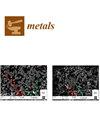降低蘑菇形 IN718 铸造合金激光束焊缝热裂纹敏感性的替代方法
IF 2.5
3区 材料科学
Q3 MATERIALS SCIENCE, MULTIDISCIPLINARY
引用次数: 0
摘要
减少热裂纹对确保镍超合金的无缝生产至关重要,镍超合金被广泛用于飞机发动机的焊接结构中。沉淀强化合金 718 中热裂纹的发生率主要受两个因素的影响:一是化学成分和凝固过程中形成的粗糙微观结构;二是热裂纹机制的激活,这在蘑菇状焊接形态中尤为关键。本研究比较了使用激光束焊接(LBW),更具体地说是板上焊珠焊接(BoP)焊接的不同镍基超合金试样。通过应用连续和脉冲 LBW,研究了具有特定化学成分的锻造和两种熔模铸造 718 合金的裂纹敏感性。此外,还分析了各种焊前处理方法,包括使用和不使用 Pre-HIP(热等静压)。研究了化学成分、枸杞多糖参数和焊前焊后处理对通过传统和先进的无损检测确定的内部和外部裂纹的影响。在镍含量(55.6% wt)和钴含量(1.11% wt)相对较高的定制 718 合金中,观察到热裂纹敏感性明显降低,整体焊接质量得到改善。本文章由计算机程序翻译,如有差异,请以英文原文为准。
Alternatives to Reduce Hot Cracking Susceptibility of IN718 Casting Alloy Laser Beam Welds with a Mushroom Shape
Reducing hot cracking is essential for ensuring seamless production of nickel superalloys, which are extensively used in welded structures for aircraft engines. The prevalence of hot cracking in precipitation-strengthened alloy 718 is primarily governed by two factors: firstly, the chemical composition and the coarse microstructure formed during solidification, and secondly, the activation of hot cracking mechanisms, which is particularly critical in mushroom-shaped welding morphologies. In this study, different nickel-based superalloys welded using laser beam welding (LBW), more specifically bead on plate welding (BoP), specimens are compared. The cracking susceptibility of both wrought and two investment casting 718 alloys with tailored chemical compositions is examined through the application of both continuous and pulsed LBW. Additionally, various pre-weld treatments, including with and without Pre-HIP (hot isostatic pressing), are analyzed. The influences of chemical composition, LBW parameters and pre- and post-welding treatments on both internal and external cracks determined by conventional and advanced non-destructive tests are studied. A clear reduction of hot cracking susceptibility and overall welding quality improvement was observed in a tailored 718 alloy with relatively high Ni (55.6% wt) and Co (1.11% wt) contents.
求助全文
通过发布文献求助,成功后即可免费获取论文全文。
去求助
来源期刊

Metals
MATERIALS SCIENCE, MULTIDISCIPLINARY-METALLURGY & METALLURGICAL ENGINEERING
CiteScore
4.90
自引率
13.80%
发文量
1832
审稿时长
1.5 months
期刊介绍:
Metals (ISSN 2075-4701) is an open access journal of related scientific research and technology development. It publishes reviews, regular research papers (articles) and short communications. Our aim is to encourage scientists to publish their experimental and theoretical results in as much detail as possible. Therefore, there is no restriction on the length of the papers. The full experimental details must be provided so that the results can be reproduced. Metals provides a forum for publishing papers which advance the in-depth understanding of the relationship between the structure, the properties or the functions of all kinds of metals.
 求助内容:
求助内容: 应助结果提醒方式:
应助结果提醒方式:


